The Swiss foundation legend
Andrej Abplanalp
4. August 2017
William Tell and the Rütli Oath – the first person to commit this to paper was Petermann Etterlin. The Lucerne city clerk wrote the first comprehensive chronicle of the Swiss Confederation.

Exhibition
The 1,000-m2 Swiss history exhibition depicts how Switzerland came to be over a period of 550 years. The tour through the centuries begins in the late Middle Ages and ends with the challenges facing democratic institutions in the present. The exhibition illustrates the journey from a confederation of states to a federal state as a struggle for identity. In addition, it crosses a time boundary that is often considered taboo for historical museums: It dares to examine contemporary history.
13:30 – 14:30 Uhr
Guided tour
13:30 – 14:30 Uhr
Guided tour
In modern times, Switzerland has remained untouched by wars. But it was not always so. For centuries, Swiss mercenaries fought all over Europe. What role did they play in Swiss politics? How did the modern federal state come into being? The tour illustrates Swiss history from the Middle Ages to the present day. If requested, special emphasis can be placed on one of three topics – politics, war, or economics.
Tour: 1 hour
Guided tours can be arranged outside opening hours: Mon between 9.30 am and 6 pm, Tue to Fri between 9.30 am and 7.45 pm. Sat and Sun between 10 am and 5 pm
| Registration: |
2 weeks in advance |
|
|
Duration: |
60 minutes; special packages can be offered on request |
|
|
Group size: |
max. 25 participants per tour |
|
|
Languages: |
English, German, Italian, French. Other offers upon request. |
|
|
Cost: |
CHF 180 for the guided tour + CHF 10 admission per person Children up to 16 years free. For groups of people with permit N, S, B, F (refugee) or F (foreigner), the guided tour and admission are free of charge. |
openinghours.days.long.monday Open till openinghours.days.long.friday openinghours.openfromto.long
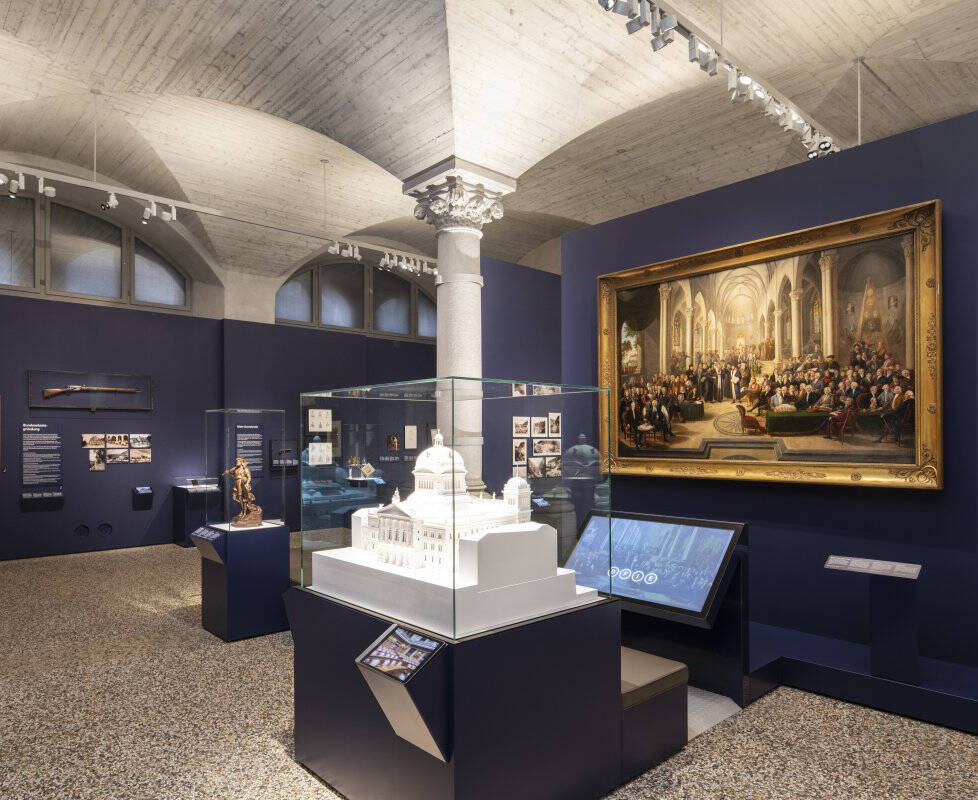
For centuries, Swiss women were excluded from civil and political rights despite being a pillar of society. What roles have women played over the last 500 years? Why was the road to women’s suffrage in Switzerland so rocky, and what has changed since its introduction in 1971? The guided tour draws attention to the interconnections permeating the history of women, sheds light on the current situation and takes a look into the future.
Tour: 1 hour
Guided tours can be arranged outside opening hours: Mon between 9.30 am and 6 pm, Tue to Fri between 9.30 am and 7.45 pm. Sat and Sun between 10 am and 5 pm
| Registration: |
2 weeks in advance |
|
|
Duration: |
60 minutes; special packages can be offered on request |
|
|
Group size: |
max. 25 participants per tour |
|
|
Languages: |
English, German, Italian, French. Other offers upon request. |
|
|
Cost: |
CHF 180 for the guided tour + CHF 10 admission per person Children up to 16 years free. For groups of people with permit N, S, B, F (refugee) or F (foreigner), the guided tour and admission are free of charge. |
openinghours.days.long.monday Open till openinghours.days.long.friday openinghours.openfromto.long
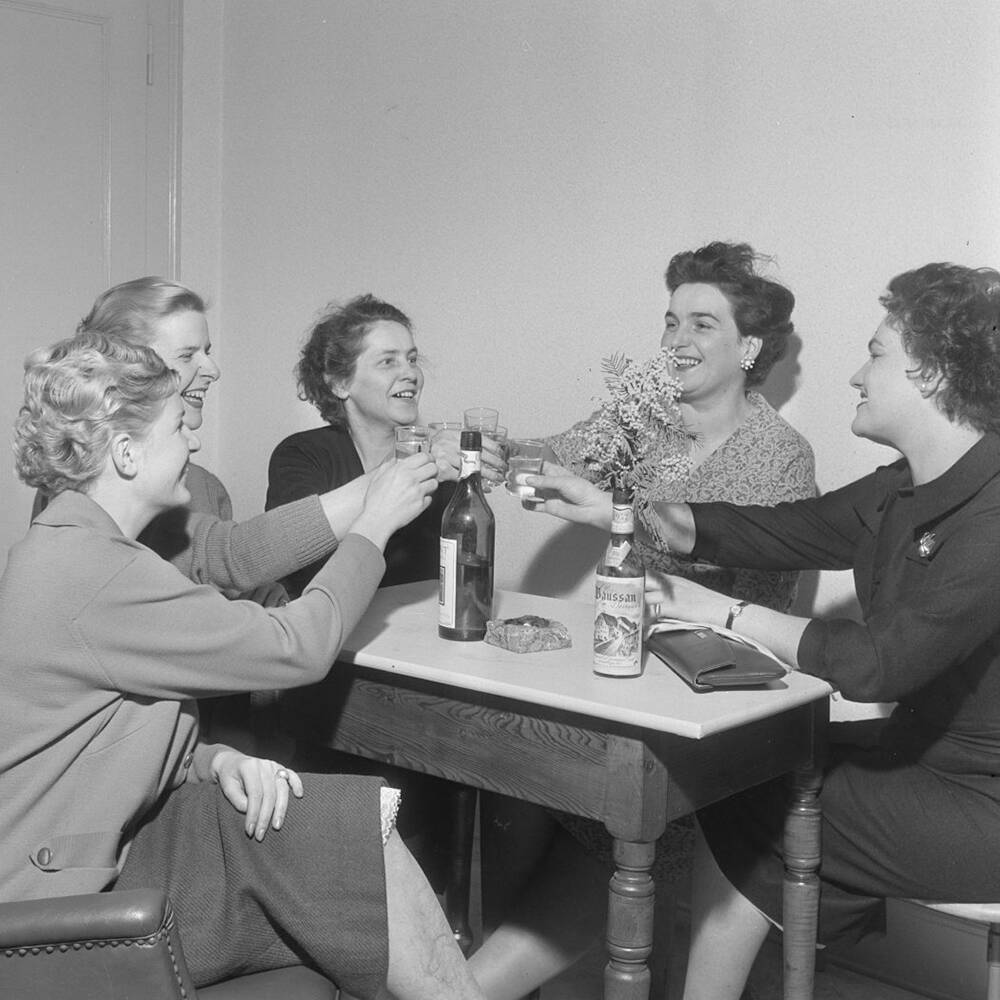
Today, Switzerland is regarded as an exemplary democracy. How did this come about? Why did the cantons unite to form a federal state? Participants will be able to trace the development of the federal state and the growth of national identity by studying selected relevant exhibits.
Tour: 1 hour
Guided tours can be arranged outside opening hours: Mon between 9.30 am and 6 pm, Tue to Fri between 9.30 am and 7.45 pm. Sat and Sun between 10 am and 5 pm
| Registration: |
2 weeks in advance |
|
|
Duration: |
60 minutes; special packages can be offered on request |
|
|
Group size: |
max. 25 participants per tour |
|
|
Languages: |
English, German, Italian, French. Other offers upon request. |
|
|
Cost: |
CHF 180 for the guided tour + CHF 10 admission per person Children up to 16 years free. For groups of people with permit N, S, B, F (refugee) or F (foreigner), the guided tour and admission are free of charge. |
openinghours.days.long.monday Open till openinghours.days.long.friday openinghours.openfromto.long
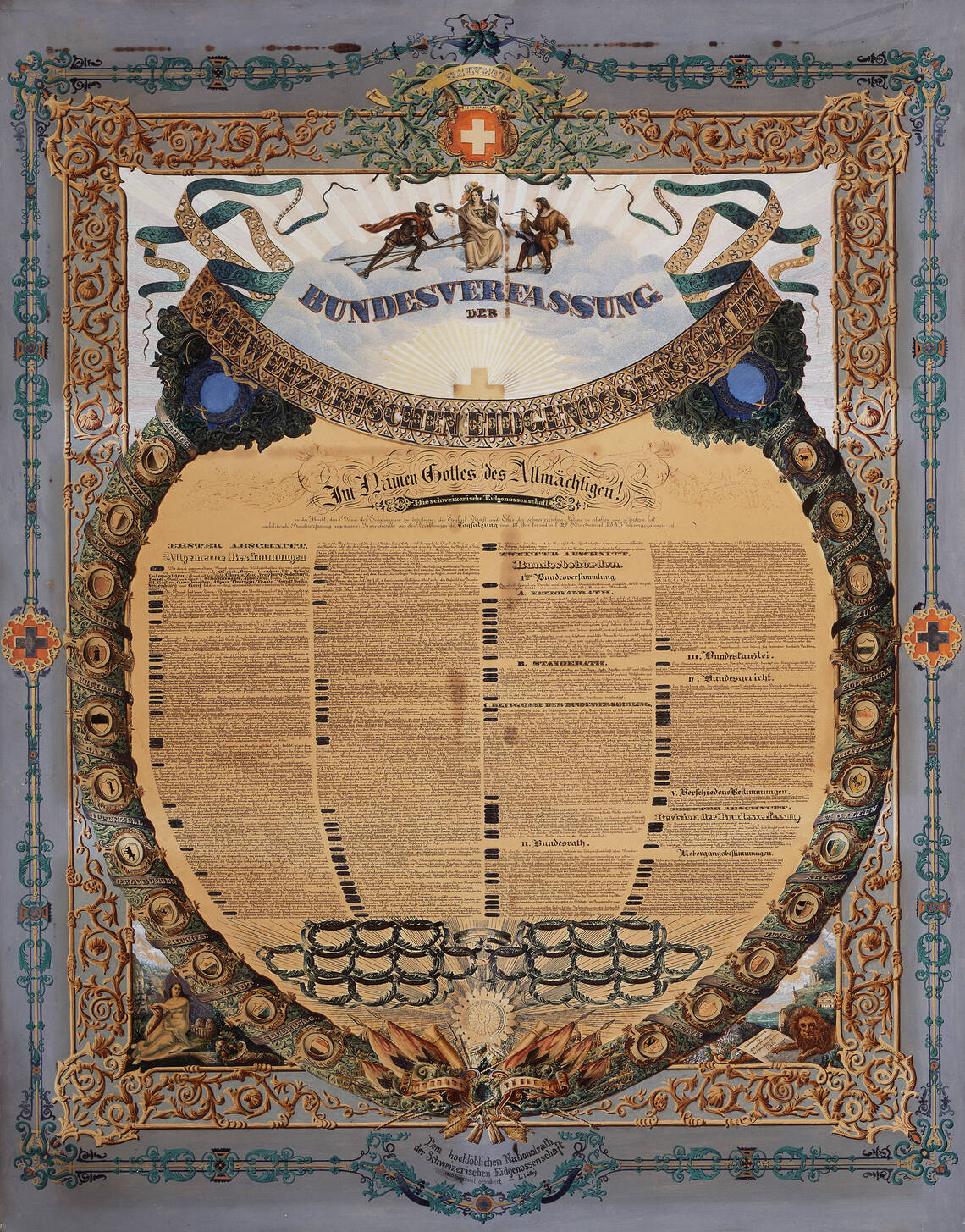
Over the years, many Swiss found work outside the country’s borders, while some even made their fortune there. At the same time, many people have come to Switzerland from abroad. Who are they? How do they cope in Switzerland? And why do people leave their home countries in the first place? Participants will study how people become refugees and migrants – from the fifteenth century to the present day.
Tour: 1 hour
Guided tours can be arranged outside opening hours: Mon between 9.30 am and 6 pm, Tue to Fri between 9.30 am and 7.45 pm. Sat and Sun between 10 am and 5 pm
| Registration: |
2 weeks in advance |
|
|
Duration: |
60 minutes; special packages can be offered on request |
|
|
Group size: |
max. 25 participants per tour |
|
|
Languages: |
English, German, Italian, French. Other offers upon request. |
|
|
Cost: |
CHF 180 for the guided tour + CHF 10 admission per person Children up to 16 years free. For groups of people with permit N, S, B, F (refugee) or F (foreigner), the guided tour and admission are free of charge. |
openinghours.days.long.monday Open till openinghours.days.long.friday openinghours.openfromto.long


With the free ‘Landesmuseum’ app, you can listen to the audio guides to the exhibitions on your own Smartphone. An innovative guide navigates you through the museum.
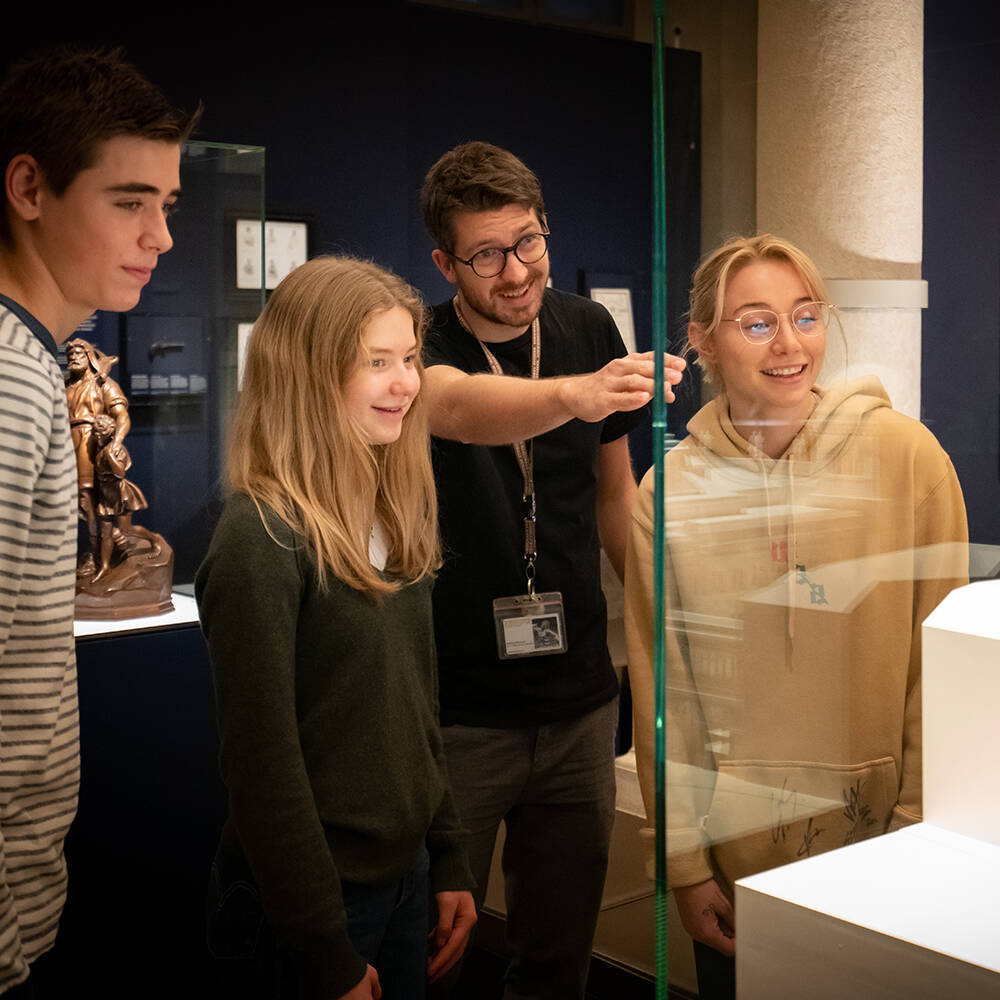
In modern times, Switzerland has remained untouched by wars. But it was not always so. For centuries, Swiss mercenaries fought all over Europe. What role did they play in Swiss politics? How did the modern federal state come into being? The tour illustrates Swiss history from the Middle Ages to the present day. If requested, special emphasis can be placed on one of three topics – politics, war, or economics.
Tour: 1 hour
Guided tours are free of charge for school classes from Switzerland.
Guided tours in English can be arranged, even outside opening hours. Guided tours are free of charge for school classes from Switzerland.
| Booking: |
at least 2 weeks in advance |
|
|
Duration: |
1 hour guided tours, other services by prior arrangement |
|
|
Group size: |
max. 25 people |
|
|
Cost: |
Guided tours for school classes from Switzerland are free of charge. |
openinghours.days.long.monday Open till openinghours.days.long.friday openinghours.openfromto.long

For centuries, Swiss women were excluded from civil and political rights despite being a pillar of society. What roles have women played over the last 500 years? Why was the road to women’s suffrage in Switzerland so rocky, and what has changed since its introduction in 1971? The guided tour draws attention to the interconnections permeating the history of women, sheds light on the current situation and takes a look into the future.
Tour: 1 hour
Guided tours are free of charge for school classes from Switzerland.
Guided tours in English can be arranged, even outside opening hours. Guided tours are free of charge for school classes from Switzerland.
| Booking: |
at least 2 weeks in advance |
|
|
Duration: |
1 hour guided tours, other services by prior arrangement |
|
|
Group size: |
max. 25 people |
|
|
Cost: |
Guided tours for school classes from Switzerland are free of charge. |
openinghours.days.long.monday Open till openinghours.days.long.friday openinghours.openfromto.long

Today, Switzerland is regarded as an exemplary democracy. How did this come about? Why did the cantons unite to form a federal state? Students will be able to trace the development of the federal state and the growth of national identity by studying selected relevant exhibits.
Tour: 1 hour
Guided tours are free of charge for school classes from Switzerland.
Guided tours in English can be arranged, even outside opening hours. Guided tours are free of charge for school classes from Switzerland.
| Booking: |
at least 2 weeks in advance |
|
|
Duration: |
1 hour guided tours, other services by prior arrangement |
|
|
Group size: |
max. 25 people |
|
|
Cost: |
Guided tours for school classes from Switzerland are free of charge. |
openinghours.days.long.monday Open till openinghours.days.long.friday openinghours.openfromto.long

Over the years, many Swiss found work outside the country’s borders, while some even made their fortune there. At the same time, many people have come to Switzerland from abroad. Who are they? How do they cope in Switzerland? And why do people leave their home countries in the first place?
Tour: 1 hour
Guided tours are free of charge for school classes from Switzerland.
Guided tours in English can be arranged, even outside opening hours. Guided tours are free of charge for school classes from Switzerland.
| Booking: |
at least 2 weeks in advance |
|
|
Duration: |
1 hour guided tours, other services by prior arrangement |
|
|
Group size: |
max. 25 people |
|
|
Cost: |
Guided tours for school classes from Switzerland are free of charge. |
openinghours.days.long.monday Open till openinghours.days.long.friday openinghours.openfromto.long
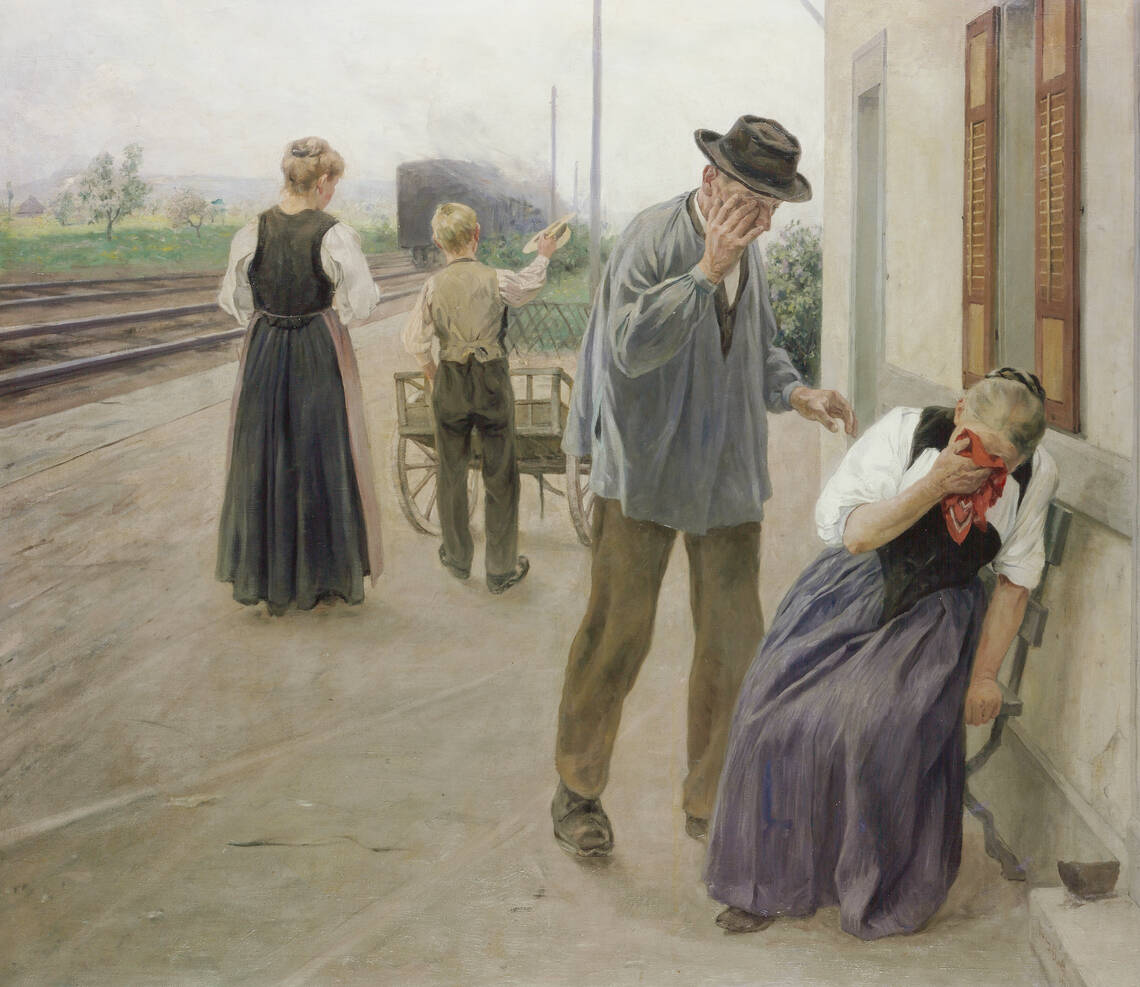
Migration has been a part of human history from the very beginning. What does it mean to leave one’s home? This interactive tour allows students to retrace migration paths, such as the story of a Jewish woman’s flight from Nazi Germany or that of a Swiss man who migrated to Sumatra and became wealthy there. Various biographies are traced and discussed.
Interactive tour: 1.5 hours
Guided tours are free of charge for school classes from Switzerland.
Guided tours in English can be arranged, even outside opening hours. Guided tours are free of charge for school classes from Switzerland.
| Booking: |
at least 2 weeks in advance |
|
|
Duration: |
1 hour guided tours, other services by prior arrangement |
|
|
Group size: |
max. 25 people |
|
|
Cost: |
Guided tours for school classes from Switzerland are free of charge. |
openinghours.days.long.monday Open till openinghours.days.long.friday openinghours.openfromto.long
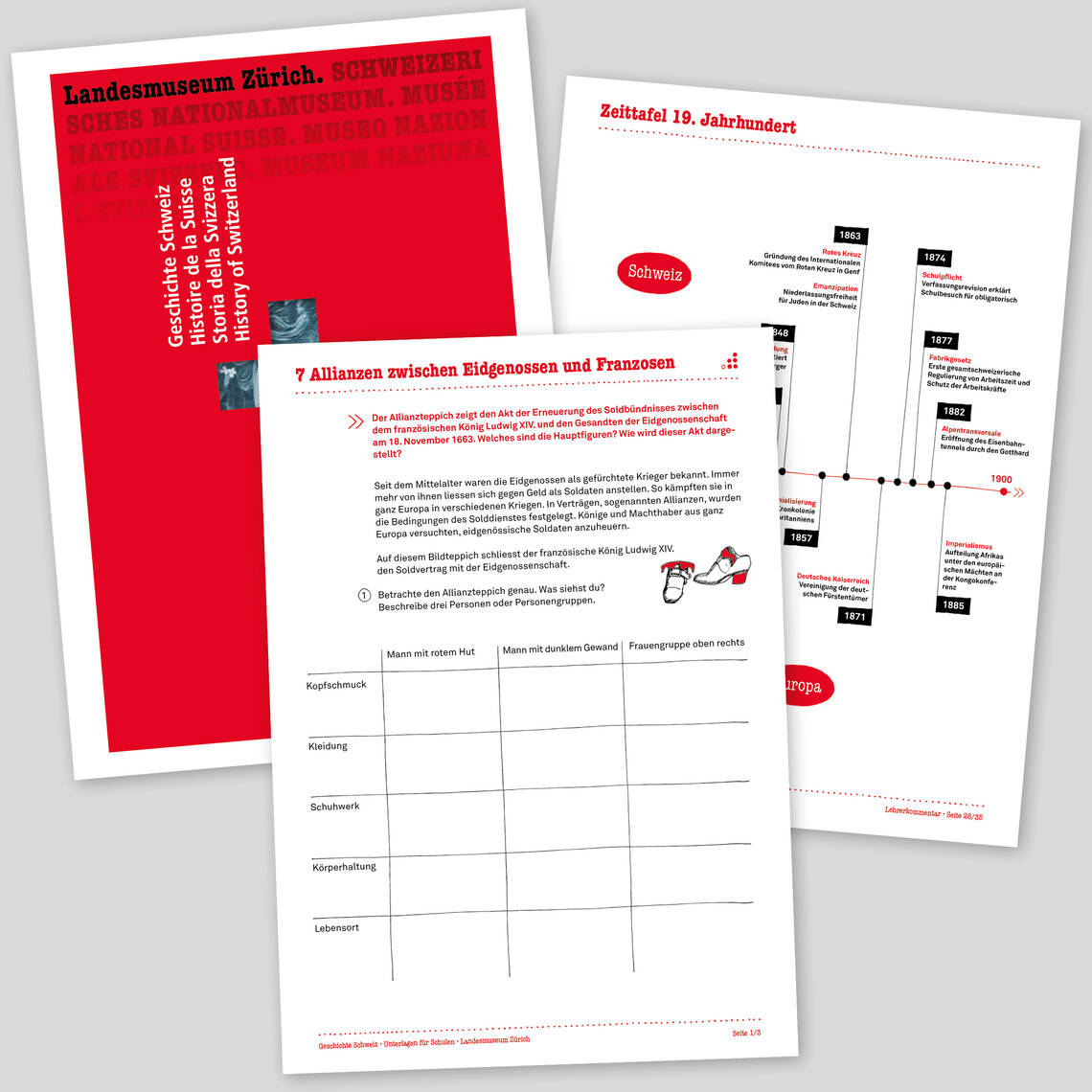
The school materials consist of work sheets designed to help students take a more in-depth look at the exhibition or at individual exhibits and topics.
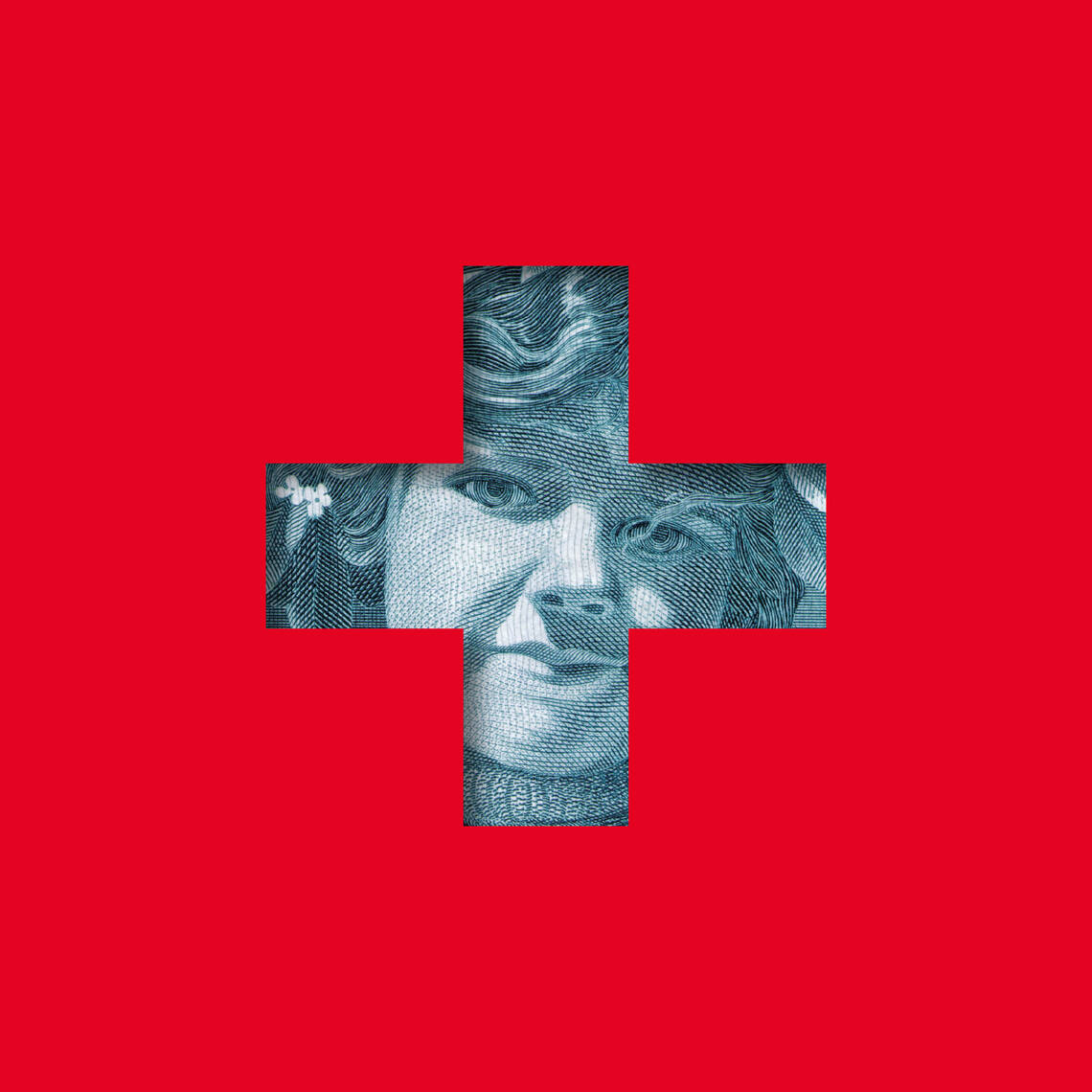
Im Raum des 19. Jahrhunderts dreht sich alles um den Staatsbildungsprozess – ein moderner Bundesstaat entsteht. Mit Tablets können die Schülerinnen und Schüler die Entstehung der Schweizerischen Demokratie erkunden. Der Rundgang besteht aus sechs Stationen: Regierung, Föderalismus, Verfassung, Zugehörigkeit, Mitbestimmung und Neutralität. Es stehen 12 Tablets für die Schulklasse zur Verfügung. Inhalt: Animationsfilme, Objektinformationen und Verständnisfragen.
Ab Sekundarstufe I | Dauer: etwa 45 - 60 Minuten.
Führungen: kostenlos und auch ausserhalb der Öffnungszeiten möglich.
| Anmeldung: |
mindestens 2 Wochen im Voraus |
|
|
Sprachen: |
Deutsch, Französisch, Italienisch und Englisch. |
Unser Newsletter für Schulen informiert Sie regelmässig über aktuelle Angebote.
openinghours.days.long.monday Geöffnet bis openinghours.days.long.friday openinghours.openfromto.long

Self-led visits by appointment only. Prior visits are free of charge for teachers from Switzerland.
Guided tours in English can be arranged, even outside opening hours. Guided tours are free of charge for school classes from Switzerland.
| Booking: |
at least 2 weeks in advance |
|
|
Duration: |
1 hour guided tours, other services by prior arrangement |
|
|
Group size: |
max. 25 people |
|
|
Cost: |
Guided tours for school classes from Switzerland are free of charge. |
openinghours.days.long.monday Open till openinghours.days.long.friday openinghours.openfromto.long

Führung durch die Ausstellung mit Inputs zur Arbeit mit Schulklassen finden regelmässig statt.
Führungen: kostenlos und auch ausserhalb der Öffnungszeiten möglich.
| Anmeldung: |
mindestens 2 Wochen im Voraus |
|
|
Sprachen: |
Deutsch, Französisch, Italienisch und Englisch. |
Unser Newsletter für Schulen informiert Sie regelmässig über aktuelle Angebote.
openinghours.days.long.monday Geöffnet bis openinghours.days.long.friday openinghours.openfromto.long
The new, 1000-m2 Swiss history exhibition depicts how Switzerland came to be over a period of 550 years – beginning in the late Middle Ages, through the early modern era to the democratic institutions challenged by globalisation today.
In addition to citizenship, the right to vote and separation of powers, a democratic society needs an integrative community. This includes participation in national institutions and identification with shared symbols. How these institutions came to be and the use of such symbols is the central theme of the new permanent “History of Switzerland” exhibition. Local, language-regional and international puzzle pieces illustrate this interplay and the development process from the Old Swiss Confederacy into a modern federal state.
The new permanent “History of Switzerland” exhibition thus takes you on a tour from the 15th to the 21st century. The journey through the centuries conveys the historical context of regional movements and international using selected exhibits: Unique manuscripts and famous pieces, such as Charles Le Brun’s Alliance Tapestry from 1663 and the anti-aircraft cannon by the Bührle company, highlight important social and economic setbacks and achievements in Switzerland. The exhibition explains the development of Switzerland at various turning points.
The history of Switzerland is also a history of borders that have been formed and repeatedly moved, whether they are geographical, linguistic or religious borders. The continually renewed attempts to overcome these divisions made it possible to become a modern, sovereign state in the heart of Europe. The exhibition also crosses a time boundary that is often considered taboo for historical museums. It dares to examine contemporary history. The part of the exhibition dedicated to the 21st century deals with global issues such as migration, climate change and robotics. Questions are posed for the present day. The answers to these questions will shape Switzerland’s future.
The Swiss National Museum would like to thank the Foundation Willy G. S. Hirzel for the generous support.

Amt für Denkmalpflege und Archäologie, Solothurn
Archiv für Zeitgeschichte ETH Zürich
Archives Contestataires, Carouge
Biofarm, Kleindietwil
Burgergemeinde Fribourg
Coop Zentralarchiv, Basel
Eidgenössisches Departement für Verteidigung, Bevölkerungsschutz und Sport, Bern
Eidgenössisches Justiz- und Polizeidepartement, Bundesamt für Polizei fedpol, Bern
Firmenarchiv der Novartis AG, Basel
Gemeinde Unterbäch
Kunstsammlung der Stadt Zürich
Mario und Hélène Comensoli Stiftung, Zürich
Max Havelaar Stiftung, Zürich
Migros-Genossenschafts-Bund, Zürich
Mirage-Verein Buochs, Wolfenschiessen
Musée d’Isérables
Museum für Musikautomaten, Seewen
Polizeimuseum, Zürich
Schweizerisches Bundesarchiv, Bern
Schweizerisches Sozialarchiv, Zürich
Stiftung für Kunst, Kultur und Geschichte, Winterthur
Stiftung Ortsarchiv Grabs
Unterallmeind Korporation Arth
Velokurierladen Bern
Verband Swissmem, Zürich
Weisbrod-Zürrer AG, Hausen am Albis
| Overall management | Andreas Spillmann | |
| Curators and project direction | Erika Hebeisen, Denise Tonella | |
| Scientific collaboration | Aaron Estermann, Sandra von Euw, Selina Stuber | |
| Research and expertise | Adrian Baschung, Jürg Burlet, Cyril Dessemontet, Andrea Franzen, Boris Hänssler, Joya Indermühle, Marco Jorio, Elisabeth Joris, Michael Jucker, Michael Kempf, Rebecca Sanders, Hans Rudolf Schelling, Christian Schorno, Daniela Schwab, Christina Sonderegger, Francesco Spöring, Texetera GmbH: Erik Thurnherr | |
| Scenography | Alex Harb | |
| Graphics | LDSGN: Thomas Lehmann mit Büro4 AG für Gestaltung + Kommunikation | |
| Graphic Key Visual | Roli Hofer | |
| Media installations | Thomas Bucher, Büro4 AG für Gestaltung + Kommunikation, Claudiabasel GmbH, Ulrich Heiniger, IJsfontein Interactive Media GmbH (Medienkonzept Sektion 21. Jh.), Pasquale Pollastro, Danilo Rüttimann, Tweaklab AG, René Vogel, Zense GmbH | |
| Audioguide and audio stations | kellerthurgau: Markus Keller, tonwelt GmbH (Mandarin) | |
| Video recordings | Alkmini Boura, Rémi Mazet | |
| Cultural services and museum education | Stefanie Bittmann, Lisa Engi, Maria Iseli | |
| Public relations and marketing | Andrej Abplanalp, Peter Krebs, Carole Neuenschwander, Alexander Rechsteiner | |
| Technical management | Mike Zaugg | |
| Exhibition construction | Hannes Baur, Bachir Ezzerari, Michelle Fässler, Gianina Flepp, Marc Hägeli, Schanon Neukom, Louis Perez, Mike Roder, David Schwitter, Debbie Sledsens | |
| Conservation management | Katharina Schmidt-Ott | |
| Conservation and montage of objects | Nikkibarla Calonder, Natalie Ellwanger, Elisabeth Kleine, Martin Ledergerber, Iona Leroy, Sarah Longrée, Uldis Mākulis, Véronique Mathieu Lingenhel, Jürg Mathys, Leila Meister-El Ansari, Claudia Merfert, Françoise Michel, Elke Mürau, Carolin Muschel, Gaby Petrak, Ulrike Rothenhäusler, Peter Wyer, Tino Zagermann | |
| Logistics of objects and montage of objects | Alder Stahl + Schweiss Wädenswil, Christian Affentranger, David Blazquez, Simon D'Hollosy, Reto Hegetschweiler, Markus Scherer | |
| Loans | Maya Jucker, Franziska Pfenninger, Bernard Schüle, Angela Zeier | |
| Advisory committee | Heidi Amrein, Ellen Bryner, Beat Högger, Markus Leuthard, Andreas Spillmann | |
| Controlling of project | Ellen Bryner | |
| Head of legal affairs and contracts |
Ursina Geissbühler, Beat Högger |
|
| Photography | Jonas Hänggi, Donat Stuppan | |
| Photo library | Andrea Kunz, Fabian Müller | |
| IT / Web | Danilo Rüttimann, René Vogel | |
| Translations | Bill Gilonis, Marco Marcacci, Laurence Neuffer, Tradukas GbR | |
| Final editing | Eva Carlevaro, Ingrid Kunz, Laurence Neuffer, Carmela Petralia, Rebecca Sanders, Miriam Waldvogel, Samuel van Willigen | |
Audio-visual archive material is used by kind permission of SRG SSR.